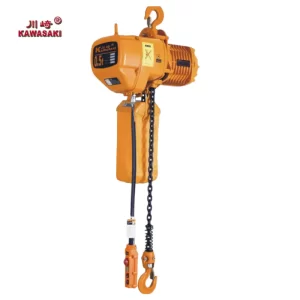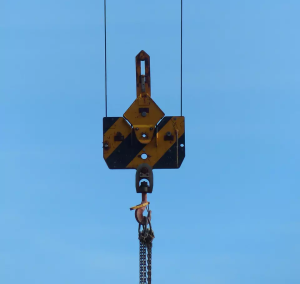Overview of Electric Hoists
Definition and Basic Working Principle
An electric hoist is a vital piece of equipment used in various industries to simplify the task of lifting and transporting heavy objects. Operating through an electric motor, an electric hoist employs a lifting mechanism, such as a chain or wire rope, to lift loads vertically. Controlled via a remote or manual switch, the system ensures precision and ease in handling burdensome tasks that would otherwise require significant manpower. These hoists are designed to improve productivity, reduce physical strain on workers, and enhance overall safety in the workplace.
Types of Electric Hoists
Chain Hoists
Chain hoists are one of the most commonly used types of electric hoists. They utilize a chain as the lifting medium and are particularly favored for their durability and ease of maintenance. Chain hoists are suitable for a variety of lifting tasks, from light to heavy-duty applications, making them versatile tools in both industrial and commercial settings. Their compact design allows for ease of transportation and installation, making them an ideal choice for limited or confined spaces.
Wire Rope Hoists
Wire rope hoists, in contrast, use a wire rope as the lifting mechanism. They are generally used for higher capacity lifting and longer lifting distances due to their robust structure. Wire rope hoists offer smooth and reliable operation, making them ideal for precision lifting tasks in demanding environments such as construction and mining. They are engineered to withstand tough conditions and provide extended service life, though they often require more meticulous maintenance compared to chain hoists.
Industrial Applications of Electric Hoists
Manufacturing Industry
In the manufacturing industry, electric hoists play a crucial role in maintaining efficiency and boosting productivity.
Assembly Line Operations
Electric hoists are commonly used in assembly line operations to facilitate the movement of heavy components. They aid in accurately positioning parts and assemblies, significantly speeding up production processes and reducing manual labor. This not only enhances throughput but also minimizes the risk of workplace injuries associated with lifting heavy items.
Material Handling
Material handling is another critical application of electric hoists in manufacturing. These devices streamline the handling of raw materials and finished products, ensuring they are moved safely and efficiently throughout the production facility. By automating these tasks, businesses can achieve a more organized workflow and reduce downtime associated with material transport.
Construction Industry
The construction industry greatly benefits from the use of electric hoists due to the heavy-lifting demands of various projects.
Lifting Heavy Building Materials
Electric hoists are indispensable in lifting and transporting heavy building materials like steel beams, concrete blocks, and other bulky items. Their ability to effortlessly lift and place these materials precisely contributes to safer and faster construction progress. This enhanced efficiency is vital for meeting tight project deadlines and maintaining a smooth worksite operation.
Equipment Positioning
Apart from lifting building materials, electric hoists are also used for positioning heavy equipment and machinery in the construction industry. Proper equipment placement is essential to ensure that machinery operates safely and effectively. Electric hoists enable accurate and stable positioning, which is crucial for the successful execution of construction tasks.
APOLLO’s Precision Engineered Electric Hoists

APOLLO’s range of lifting machinery is designed to meet the diverse needs of various industries, from construction and manufacturing to logistics and beyond. Their electric hoists, in particular, are a testament to their commitment to excellence. These hoists are engineered with precision, ensuring that heavy lifting tasks are not only simplified but also executed with utmost safety and efficiency.
One of the standout features of APOLLO’s electric hoists is their advanced technology. Equipped with intelligent control systems, these hoists offer remote operation and monitoring capabilities, providing operators with greater flexibility and control. This is particularly beneficial in complex construction environments where precision and safety are paramount.
Moreover, APOLLO’s electric hoists are designed with durability in mind. Constructed from high-quality materials, they are built to withstand the rigors of demanding industrial applications. This ensures a longer service life and reduces the need for frequent maintenance, thereby lowering operational costs.
Commercial and Residential Uses of Electric Hoists
Warehousing and Storage
Electric hoists are also extensively used in commercial settings such as warehouses and storage facilities.
Loading and Unloading Goods
In warehousing operations, electric hoists streamline the loading and unloading of goods, allowing for faster turnaround times. They enable workers to handle heavy merchandise more safely, reducing the risk of injury and product damage. This efficiency is essential for maintaining a steady flow of goods in and out of storage areas.
Organizing Storage Areas
Organizing storage areas is another critical application for electric hoists. They assist in positioning heavy items on high shelves and organizing inventory more effectively. This optimized organization helps maximize storage space and ensure that items are easily accessible when needed.
Home Use
Electric hoists have found a niche in residential applications as well.
Garage Projects
In home garages, electric hoists simplify tasks such as lifting engines, heavy tools, and other substantial objects. They make it easier for hobbyists and DIY enthusiasts to work on projects without straining themselves, ensuring that heavy items are securely lifted and lowered.
DIY Tasks
For various DIY tasks around the home, electric hoists offer an extra level of convenience and safety. From installing heavy fixtures to carrying out renovations, these versatile tools make challenging tasks manageable for homeowners, promoting greater independence and efficiency.

Safety and Maintenance Considerations for Electric Hoists
Safety Measures While Operating
Safety is paramount when operating electric hoists. Operators must receive proper training on how to use the equipment to prevent accidents. It’s essential to follow the manufacturer’s instructions and guidelines to ensure safe operation. Additionally, regular safety checks should be conducted to ensure that the hoist’s mechanisms are functioning correctly. Personal protective equipment (PPE) such as gloves, helmets, and safety shoes should always be worn while operating hoists to prevent injuries from accidental drops or faulty equipment.
Regular Maintenance Procedures
Inspection
Consistent inspection is crucial for the reliable operation of electric hoists. Regularly checking the hoist for wear and tear, especially the lifting chains or wire ropes, can prevent potential failures. Inspections should include examining the hooks for distortions, checking for oil leaks, and verifying that all control buttons and emergency stop functions are working properly.
Lubrication
Proper lubrication of the moving parts of an electric hoist is essential to ensure smooth operation and extend the equipment’s lifespan. Applying the correct lubricant to the gears, chains, or ropes reduces friction and wear, keeping the hoist in optimal working condition. This routine maintenance task helps prevent unexpected downtimes and costly repairs.
Advantages and Limitations of Using Electric Hoists
Benefits
Efficiency and Speed
One of the significant advantages of using electric hoists is their efficiency and speed. They can lift heavy loads quickly and with minimal effort, significantly reducing the time required for lifting and transporting tasks. This efficiency is particularly beneficial in industries where time is a critical factor, such as construction and manufacturing, resulting in increased productivity.
Reduced Labor Costs
By automating heavy lifting tasks, electric hoists reduce the labor required for manual lifting. This not only minimizes the physical strain on workers but also decreases the number of personnel needed for specific tasks. Consequently, businesses can reduce labor costs and allocate human resources to other critical operations, enhancing overall organizational efficiency.

